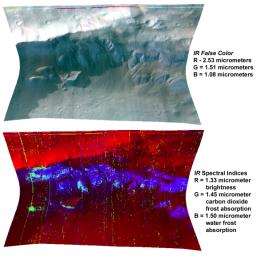
|
Seasonal Frost in Terra Sirenum
- Click the image above for a larger view
- Full-Res JPEG (1728 x 1728) (367.2 kB)
- Full-Res TIFF (1728 x 1728) (9.0 MB)
Caption:
This image of the Terra Sirenum region of Mars was taken by the Compact Reconnaissance Imaging Spectrometer for Mars (CRISM) at 0918 UTC (4:18 a.m. EST) on Nov. 25, 2006, near 38.9 degrees south latitude, 195.9 degrees east longitude. CRISM's image was taken in 544 colors covering 0.36-3.92 micrometers, and shows features as small as 18 meters (60 feet) across.
At this time, Mars' southern hemisphere was experiencing mid-winter. During Martian southern winter, the southern polar cap is covered and surrounded by carbon dioxide frost and water frost. This is unlike Earth, whose frozen winter precipitation is made up of only one volatile -- water. The carbon dioxide frost evaporates, or sublimates, at a lower temperature than water frost. So, during spring, the carbon dioxide ice evaporates first and leaves a residue of water frost, which later sublimates as well.
The image shown here covers part of a crater rim, which is illuminated from the upper left. North is at the top. The topography creates a cold microenvironment on the south side of the rim that is partially protected from solar illumination. That cold surface contains an outlier of the southern seasonal frost about 15 degrees of latitude closer to the equator than the average edge of the frost at this season.
The top image was constructed from three infrared wavelengths that highlight the bluer color of frost than the background rock and soil. Note that the frost occurs both on sunlit and shaded surfaces on the south side of the rim. The shaded areas are still visible because they are illuminated indirectly by the Martian sky.
The bottom image was constructed by measuring the depths of spectral absorption bands due to water frost and carbon dioxide frost, and displaying the results in image form. Blue shows strength of an absorption due to water frost near 1.50 micrometers, and green shows strength of an absorption due to carbon dioxide frost near 1.45 micrometers. Red shows brightness of the surface at 1.33 micrometers -- outside of the frost absorption bands -- in order to show the relationship of frost to the illuminated crater rim.
In comparing the top and bottom images, note that water frost occurs in many locations on the south-facing side of the crater rim, both in sunlit and shaded areas. Because it faces away from the sun, this side of the crater rim is colder than the north, sun-facing side. This favors the formation of frost. In contrast, carbon dioxide frost occurs only in the coldest, most shaded areas.
Background Info:
CRISM's mission: Find the spectral fingerprints of aqueous and hydrothermal deposits and map the geology, composition and stratigraphy of surface features. The instrument will also watch the seasonal variations in Martian dust and ice aerosols, and water content in surface materials -- leading to new understanding of the climate.
The Compact Reconnaissance Imaging Spectrometer for Mars (CRISM) is one of six science instruments on NASA's Mars Reconnaissance Orbiter. Led by The Johns Hopkins University Applied Physics Laboratory, the CRISM team includes expertise from universities, government agencies and small businesses in the United States and abroad.
Cataloging Keywords:
| Name | Value | Additional Values |
|---|---|---|
| Target | Mars | |
| System | ||
| Target Type | Planet | |
| Mission | Mars Reconnaissance Orbiter (MRO) | |
| Instrument Host | Mars Reconnaissance Orbiter | |
| Host Type | Orbiter | |
| Instrument | Compact Reconnaissance Imaging Spectrometer for Mars (CRISM) | |
| Detector | ||
| Extra Keywords | Color, Crater, Dust, Infrared, Map, Thermal, Water | |
| Acquisition Date | ||
| Release Date | 2006-12-22 | |
| Date in Caption | 2006-11-25 | |
| Image Credit | NASA/JPL/JHUAPL | |
| Source | photojournal.jpl.nasa.gov/catalog/PIA09101 | |
| Identifier | PIA09101 | |
